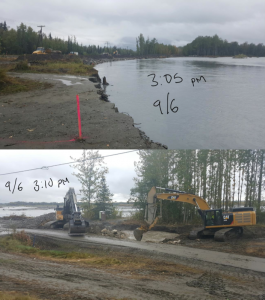
DOT work crews were dumping massive rocks, some weighing 3,000 pounds, into a 1100 foot trench constructed along the Matanuska River to help divert riverwater from reaching the highway and swamping the electric utility lines bordering the road.
About forty homes along a two-mile stretch of riverbank are threatened by erosion, and the fast disappearing bank is allowing river water to creep uncomfortably close to the Old Glenn Highway.
The river, fed by glacial melt, has been chewing away at its South bank close of the Old Glenn between mile 13 and 15 where the road runs through the Palmer neighborhood known as the Butte.
Jim Sykes represents that community on the Matanuska-Susitna Borough Assembly. Sykes appealed directly to Governor Bill Walker in mid-August for state help in stemming the erosion.
“Not only did we get the emergency intervention, we got the state DOT to protect people, property and the road all at the same time, so I am very pleased about that.” Sykes said this week.
The state authorized a disaster declaration for the Matanuska-Susitna Borough on August 22, triggering the release of $1 million in state funds to begin the work.
Department of Transportation spokesperson Shannon McCarthy says to date, the project has been largely successful in holding the water back from the highway.
“By putting this rock in, it deflects the river, the force of the river away from the road.”
McCarthy says the state has released another one million dollars in funds from the Department of Military and Veterans’ Affairs to pay for the remainder of the erosion mitigation work.
But the erosion problem has been going on for years in the Butte, as well as in other river communities, such as Sutton.
Butte resident Calvin Hall lives near the river and has been watching the most recent project carefully.
“It’s a band aid that I don’t think was overly well thought out, they didn’t have a lot of time. But big picture, it doesn’t solve much of anything. There are way too many places where this river can fail and go right across the highway and do a pretty devastating flood.”
Hall says the river current naturally forms gravel bars in the riverbed that push water into one channel or another. He says material carried by the current is dumped on the west bank, pushing the water to the opposite side and causing erosion.
Hall says dredging the riverbed is one solution, and Assemblyman Jim Sykes says he’s in favor of it, too, but the cost and constant maintenance of a dredging plan is prohibitive at this time.
Sykes is also keeping a close eye on the work, which also has built a rock wall along the riverbank to shore up the erosion prone areas.
“It was kind of a dicey deal, and when you have this embankment that is built up of silt and gravel and doesn’t have much structure, and water is trying to erode it away, it is not an easy force to deal with. They have put a lot of rocks in, they have lined the bank in some instances, and the river is heading out to the middle, and that looks like good news. ”
The Borough and the state have been squabbling over who will pay for the erosion mitigation work for years, ever since the river washed away a flood control dike built in the 1980s.
Borough spokesperson Patty Sullivan says the Borough is prohibited from working on the state-owned river to begin with. The Borough can only work on Borough land, she says, adding that the Borough had proposed a special assessment area for riverside homeowners three years ago to help pay for erosion abatement. That proposal was turned down. Sykes says a federal buy-back program is an option to remove families impacted by the river erosion, although not a popular plan with residents who have lived there for generations.
Sykes, who toured the site on Thursday, says the erosion control work is successful, at least for the time being. He adds that the new level of cooperation between the state and the Borough could result in a permanent fix for the problem.
APTI Reporter-Producer Ellen Lockyer started her radio career in the late 1980s, after a stint at bush Alaska weekly newspapers, the Copper Valley Views and the Cordova Times. When the Exxon Valdez ran aground in Prince William Sound, Valdez Public Radio station KCHU needed a reporter, and Ellen picked up the microphone.
Since then, she has literally traveled the length of the state, from Attu to Eagle and from Barrow to Juneau, covering Alaska stories on the ground for the AK show, Alaska News Nightly, the Alaska Morning News and for Anchorage public radio station, KSKA
elockyer (at) alaskapublic (dot) org | 907.550.8446 | About Ellen




